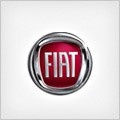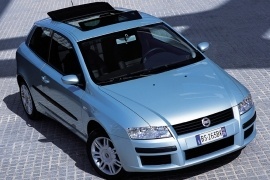
FIAT Stilo 3 Doors
Generations Timeline, Specs and Pictures

Fiat introduced the Stilo in 2001 as a top contender in the compact segment, but it failed to be a key player.
The Italian carmaker tried to bump the sales and introduced a facelift for it in 2006.
Offered in three- and five-door versions, as a hatchback or as a station-wagon, the Stilo was a daring project for Fiat. It provided an advanced design, a huge open-top glass-roof, and torsion-beam rear suspension. It was often criticized to have a “too German” look.
Fiat installed a new grille design with a horizontal, silver slat that supported the badge at the front. Its headlights featured clear lenses and the same angular shape as before. A big aesthetic improvement was for the door-handles, which were painted in body color. Before the facelift, they were black.
Inside, Fiat changed the air-vents and added aluminum trims made out of plastic. They replaced the black ones used on the non-facelifted version. The entire range received white dials for the instrument cluster. A major update was the infotainment system, which received a color touch-screen. It was still placed in a difficult-to-see area on the center stack.
Fiat dropped the 1.2-liter engine under the hood, which was carried over from Punto, and the base version featured a 1.4-liter four-mill. An interesting option was for the diesel version, which was paired to a standard 5-speed manual, and, as an option, the customer could get a 6-speed manual.

Fiat replaced the Bravo/Brava lineup in 2001 with a less mesmerizing nameplate: Stilo.
The carmaker produced it in three body versions, including a three-door hatchback.
After the bio-design era, Fiat was ready to return to some sharp lines and clean-cut edges, and the Stilo was exactly that. Regardless of its body shape, the Stilo looked good in any trim and in any company; however, the three-door version was the closest thing to the hot-hatch territory. But its sales were under the expectations.
On paper, the Stilo had all the necessary credentials to become a hot hatch. Its design was fresh with angular lines and a raked windshield. The three-doors version looked very sporty, even with steel wheels. Its rectangular openings in the front bumper and the slatted grille created a crisp image for the sporty-looking Italian hatchback. Depending on the trim level, it featured steel or light-alloy wheels.
Inside, the carmaker installed bucket seats at the front with enough bolstering to keep its occupants in place during hard cornering. The instrument cluster featured black dials with red needles for most of the engines available. A panoramic retractable glass-roof was available as well. Fiat installed a split-folding bench for the rear passengers, which came in handy to expand the trunk from 305 liters (10.8 cu-ft) to 1000 liters (35.3 cu-ft).
Under the hood, Fiat installed a wide choice of engines ranged between 80 hp and 170 hp and that including the five turbo-diesel versions, which promised a low fuel consumption.

Once a glorious name on the tracks, the Abarth ended up being just a trim level in 2001, when Fiat added its name on the Stilo range.
Fiat didn’t have big plans with Abarth in those times. Later on, it tried to revive it and brought it on more important models such as the Abarth 124. But in 2001, Abarth was employed to build a sportier version of the Stilo and transform it into a hot-hatch. Well, it didn’t!
On paper, the Stilo had all the necessary credentials to become a hot hatch. Its design was fresh with angular lines and a raked windshield. The three-doors version looked very sporty, even with steel wheels, but the Abarth was different. It stood proud on a set of five-spoke light alloys, and the front bumper featured three air-intakes to cool the engine and the brakes.
Inside, the carmaker installed bucket seats at the front with enough bolstering to keep its occupants in place during hard cornering. The instrument cluster featured white dials with red needles to emphasize the car’s sporty character, and a thick steering wheel with buttons on it was available. A panoramic retractable glass-roof was available as well.
Under the hood, Abarth failed to deliver an engine up to its name. The 2.4-liter five-mill produced a mere 170 hp, while its main competitors from Honda and Volkswagen provided more from smaller engines, with or without a turbocharger.























































